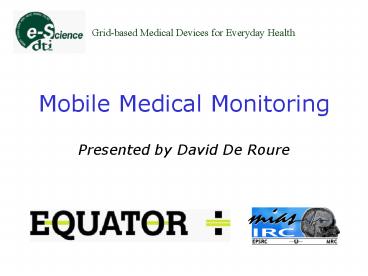Mobile Medical Monitoring Presented by David De Roure - PowerPoint PPT Presentation
1 / 32
Title:
Mobile Medical Monitoring Presented by David De Roure
Description:
Based on s provided by Chris Greenhalgh, University of Nottingham, and Don Cruickshank, University of Southampton – PowerPoint PPT presentation
Number of Views:135
Avg rating:3.0/5.0
Title: Mobile Medical Monitoring Presented by David De Roure
1
Mobile Medical MonitoringPresented by David De
Roure
Grid-based Medical Devices for Everyday Health
2
Overview of talk
- Partners
- Scenario
- Grid software
- Demonstration
- Current activity
- Closing thoughts
3
Technical innovation in physical and digital life
- Henk Muller (Bristol), Matthew Chalmers
(Glasgow), Adrian Friday, Hans Gellerson
(Lancaster),Steve Benford, Tom Rodden
(Nottingham), Bill Gaver (RCA), David De Roure
(Southampton),Geraldine Fitzpatrick (Sussex),
Anthony Steed (UCL)
4
(No Transcript)
5
- University of NottinghamTom RoddenChris
GreenhalghAlastair HampshireJan HumbleJohn
CroweBarry Hayes-GillCarl BarrattBen
PalethorpeMark Sumner - University of OxfordLionel TarassenkoWilliam R.
CobernOliver J. Gibson
University of SouthamptonDavid De RoureDon
Cruickshank University of GlasgowMatthew
Chalmers University of BristolHenk MullerChris
Setchell University of LancasterAdrian
FridayOliver StorzNigel Davies
6
Scenario
- Patients are remotely monitored using a series of
small mobile and wearable devices constructed
from an arrangement of existing sensors - Information collected from these remote devices
is made available using Grid technology - Medical professionals have tools to analyse
on-line medical information and are able to
access these through remote interfaces.
7
Grid Research Agenda
- Making remote data available to the Grid in order
that a wider scientific community can access
scientific data as quickly as possible, often
across variable bandwidth communication services - Making Grid facilities available to remote users
when these need to be delivered across lower
bandwidth communication using devices with
significant display and processor limitations
8
The Maturing eScience Grid
1998
2001
2003
2005
9
MIAS - Devices
- Exploring the development of mobile medical
technologies that can be remotely connected onto
a distributed grid infrastructure - Continuous monitoring of multiple signals via
wearable devices - Periodic monitoring using Java phones and blood
glucose measures - All signals available to a broad community and
can be processed using standard Grid Services
10
Grid protocol
Java Phone Blood Monitor
StandardGrid Service for feature detection
Proxy Buffers Material for sending on
Grid based Storage Services
Grid protocol
Grid protocol
Patients
Visualisation Services
Proxy Converts Signals to database record
Wearable Devices
Grid protocol
Display
Clinicians
11
Wearable Device
Sensor bus
- Easy Plug and Play of Sensors
- Wireless connection using 802.11
- Positioning information from GPS
- Nine wire sensor bus running through wearable to
allow new sensors
GPS aerial
12
Range of different sensors
- ECG
- Oxygen saturation
- Body movement
- Accelerometers
- GPS
- All plug and play to standard bus
- Changes reported to the underlying infrastructure
13
Blood Glucose Monitoring
- Exploring medical devices that rely on
self-reporting - Extends web based system developed by Oxford
University and e-San Ltd - Off-the-shelf GPRS (General Packet Radio Service)
mobile phone - Blood Glucose meter
14
Self Reporting
- Patient takes measurement
- Measurement sent via mobile phone to remote
infrastructure - Series of lifestyle questions asked as part of
the clinical trial - Users promoted for compliance.
- Current trial involves 100 patients
15
Deploying on the Grid
16
Putting devices on the Grid
- Make devices and sensors available as if they
were first class Grid Services - Two new application-independent port types
- a generic sensor,
- a generic device (assumed to host a number of
sensors) - Currently our devices require a proxy to match
between these definitions and the sensor - Project was an early GT3 adopter for prototype
- Grid Service model worked
- concerns about security
17
Sensor port type self-description
Sensor port type Externally modifiable
configuration
Sensor port type measurement
18
Demo at All Hands Meeting in Nottingham, 2003
19
(No Transcript)
20
(No Transcript)
21
(No Transcript)
22
Related activities
Advanced Grid Interfaces for Environmental
e-Science in the Lab and in the Field
- The Antarctic Lake Carbon Cycling project
- The Urban Pollution Monitoring Project
- See demonstrationsor www.equator.ac.uk
23
Live clinical record
- Readings appear as a live database
- Standard queries and interfaces can be used to
manipulate the data - On-line services used to process the data
- Exploits existing grid standards for reliability
- Presents a range of different interfaces for
clinicians - Provides range of feedback to patients.
24
Portal for Information Access
- Interactive access to live and stored information
(e.g. visualised, excel) collected from wearable
devices - For use by clinicians
- Could be used by patients
- Also needed by pervasive support desk
- Accessible via pervasive devices, e.g. phone
- Based on spatial model
25
(No Transcript)
26
(No Transcript)
27
Location ontology
Ian Millard
28
Semantic
Pervasive
Grid
29
Fundamentally about Interoperability and
inference
Grid and Pervasive share issues in large scale
distributed systems. e.g. service description,
discovery, composition autonomic computing.
These can be aided with semantics.
Pervasive applications need the Grid, e.g.
Sensor Networks
Grid applications need Pervasive Computing e.g.
Smart Laboratory
30
http//ubigrid.lancs.ac.uk/
31
Conclusion
- We have demonstrated the collection of medical
and contextual data from wearable devices using
Grid infrastructure - We have demonstrated a means of access to that
data by a variety of users including use of
pervasive devices - We have provided an illustration of the important
relationship between Grid and Pervasive computing
32
- www.equator.ac.uk































